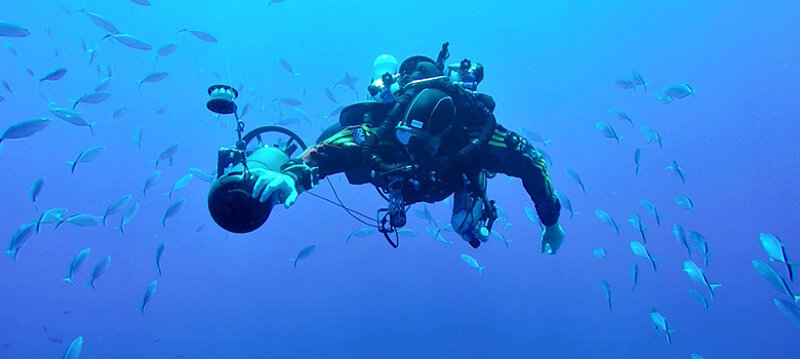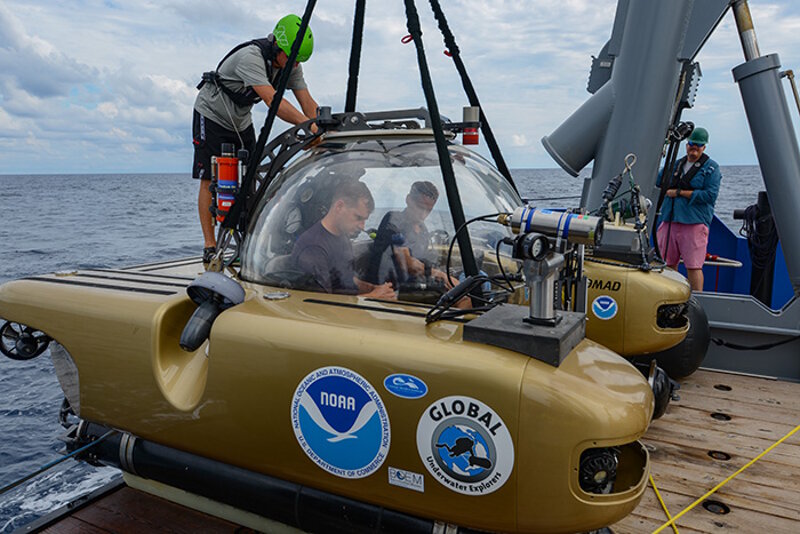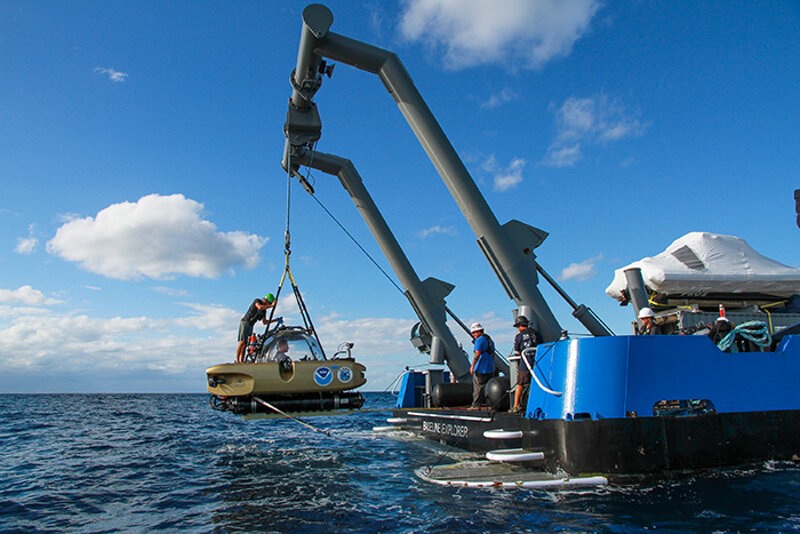
By Todd Kincaid, Director of Science and Conservation - Project Baseline
September 1, 2016

GUE-Project Baseline diver and fish. Image courtesy of Project Baseline. Download larger version (jpg, 157 KB).
Global Underwater Explorers (GUE) is a U.S. non-profit 501(c)(3) organization whose mission focuses on training and supporting a global network of highly skilled divers to engage in underwater exploration and conservation. Since the organization was founded in 1998, GUE has trained more than 10,000 divers worldwide and conducted or supported dozens of privately funded underwater exploration projects in numerous countries and in all manners of environments (reefs, wrecks, caves, lakes, rivers, springs).

BOEM archaeologist Willie Hoffman and pilot Randy Holt prepare for a submersible dive. Image courtesy of John McCord UNC CSI – Battle of the Atlantic expedition. Download larger version (jpg, 11.2 MB).
Going beyond the excitement and rigors of exploring these uncharted places, more than 60 of the GUE teams have committed themselves to recording how the underwater world is changing through time – for good or bad – through a conservation effort they call Project Baseline. To help execute and promote the Project Baseline mission, GUE board members launched a separate company called GlobalSubDive to assemble and operate a 146-foot research vessel Baseline Explorer along with two two-person, 1,000-foot rated observation submersibles and a state-of-the-art technical diving support system for scientific and conservation projects in the Atlantic Ocean and its neighboring seas.

The submersible is being lifted out of the water after a dive to be parked onboard the R/V Baseline Explorer. Image courtesy of David Sybert, UNC CSI – Battle of the Atlantic expedition. Download larger version (jpg, 2.3 MB).
In August 2016, GUE and GlobalSubDive teamed with NOAA, the Bureau of Ocean Energy Management (BOEM), and the University of North Carolina Coastal Studies Institute to explore and document a series of shipwrecks off the coast of Cape Hatteras, North Carolina, which is known as the “Graveyard of the Atlantic.”
The specific wrecks were engaged in the World War II Battle of the Atlantic. The two primary targets are the German submarine U-576 that was sunk in battle and its last victim, the cargo ship Bluefields. Both ships rest on the seafloor in approximately 800 feet of water, 35 miles offshore. Due to the depth, these wrecks will be studied with the use of the two-person submersibles. Other targets include shallower wrecks that lie between 200 and 400 feet of water, where the goal will be to team the submersibles with four-person dive teams to more quickly document each wreck.
In all cases, the primary objectives will be to establish baselines for the condition of the wrecks both from a structural-archeological and an environmental perspective, which makes this mission a perfect first opportunity for a collaboration with GUE and GlobalSubDive to engage in the initiative, Project Baseline. Not only will the results of the mission feed data directly into Project Baseline’s database, but it will also be used to develop specific baseline conditions to support NOAA’s efforts to manage conditions in the Monitor National Marine Sanctuary.
Together, we will focus public attention on the exciting opportunities for human endeavors underwater and on the delicate condition of our marine environments. The broader and exciting outcome from the 2016 Battle of the Atlantic project will be a demonstration of the value of direct human engagement in ocean exploration and research and more opportunities to bring people into the seas through direct and virtual participation in the exploration of the underwater environments being protected by our national marine sanctuaries.